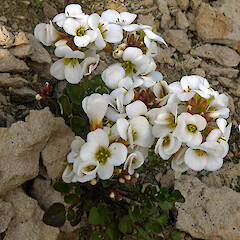Cardamine magnifica
Common name
Castle Hill bittercress
Synonyms
None - first described in 2019
Family
Brassicaceae
Flora category
Vascular – Native
Endemic taxon
Yes
Endemic genus
No
Endemic family
No
Structural class
Herbs - Dicotyledons other than Composites
Interim conservation status
The conservation status of all known New Zealand vascular plant taxa at the rank of species and below were reassessed in 2017 using the New Zealand Threat Classification System (NZTCS) – more information about this can be found on the NZTCS website. This report includes a statistical summary and brief notes on changes since 2012 and replaces all previous NZTCS lists for vascular plants.
Please note, threat classifications are often suggested by authors when publications fall between NZTCS assessment periods – an interim threat classification status has not been assessed by the NZTCS panel.
- Conservation status of New Zealand indigenous vascular plants, 2017 . 2018. Peter J. de Lange, Jeremy R. Rolfe, John W. Barkla, Shannel P. Courtney, Paul D. Champion, Leon R. Perrie, Sarah M. Beadel, Kerry A. Ford, Ilse Breitwieser, Ines Schönberger, Rowan Hindmarsh-Walls, Peter B. Heenan and Kate Ladley. Department of Conservation. Source: NZTCS and licensed by DOC for reuse under the Creative Commons Attribution 4.0 International licence.
2019 | Threatened – Nationally Critical | Qualifiers: DP | Interim
Brief description
Allied to Cardamine glara from which it differs by its more robust growth habit, strongly rhizomatous stems, larger and thicker leaves, conspicuous and larger flowers, larger sepals and petals, longer anthers, filaments and styles, and longer seeds with a winged margin.
Distribution
Endemic. South Island, Canterbury, Castle Hill Basin (including Castle Hill, Gorge Hill, and Prebble Hill).
Habitat
A plant inhabiting fine-grained limestone scree, stony colluvium, and also growing on t the margins of associated sparsely vegetated, stable to semi-stable limestone rock outcrops and bluffs.
Detailed description
Perennial herb, single rosette or with short lateral branches, stem and branches 1.0–1.5 mm diameter, strongly rhizomatous. Leaves up to 80 mm long, pinnatisect; lamina 10.2–55.0 × 12.0–28.0 mm, grey-green, light green, greenish-yellow, sometimes purplish beneath, coriaceous, usually glabrous, occasionally with sparsely hairy margins and petiole. Terminal pinna 4.0–16.0 × 4.0–17.0 mm, usually simple, sometimes with 1–2 very shallow lobes, orbicular, orbicular-rhomboid, to broadly elliptic-rhomboid, margin often irregular, apex obtuse with a conspicuous hydathode, base obtuse, truncate or weakly cordate and sometimes oblique. Lateral pinnae 2–4, 2.0–11.0 × 2.0–10.0 mm, orbicular, orbicular-rhomboid, to broadly elliptic-rhomboid, petiolule 0.5–8.0 mm long. Petiole up to 65 mm long; hairs septate and 0.3–0.4 mm long. Cauline leaves similar to rosette leaves but smaller and with fewer lateral pinnae. Inflorescence racemose, 7–15-flowered; peduncle up to 140 mm long, 0.8–1.4 mm diam. at base, upright, glabrous. Pedicels 12.0–37.0 mm long, 0.4–0.5 mm diam., glabrous. Sepals 2.6–4.5 × 1.5–2.2 mm, elliptic-oblong to broadly elliptic, ± saccate, green or red-brown, usually glabrous or occasionally sparsely hairy in distal half, margin translucent or white, membranous, apex obtuse, base truncate. Petals 7.6–11.3 × 3.8–5.0 mm, white, limb obovate to broadly elliptic; apex obtuse; base cuneate, tapering to a 1.0–1.4 mm long claw. Stamens 6; median filaments 4, 3.6–4.0 mm long; lateral filaments 2, 3.2–3.4 mm long; anthers 0.8–0.9 mm long, cream to pale yellow, when dehiscent held at a similar height to or slightly below the stigma. Ovary 3.5–4.2 mm long, 0.5–0.6 mm diam., ± terete, green, glabrous; ovules 18–22; style 2.0–4.0 mm long, ± terete; stigma 0.7–0.8 mm diam. Siliques 33.0–40.0 × 1.5–1.8 mm, glabrous, style 1.8–3.0 mm long; valves green to red-brown at maturity; straw-coloured when dehiscent, replum 0.3–0.4 mm wide. Seeds 1.4–1.9 mm long, 0.7–1.1 mm wide, 0.3–0.5 mm thick, broad-oblong, oblong to oblong-elliptic, yellowbrown to henna; wing present.
Similar taxa
At Castle Hill Basin, Cardamine magnifica occurs with C. coronata, C. glara and C. intonsa. In comparison to C. glara, C. magnifica has a more robust growth habit, strongly rhizomatous stems, thicker, more robust and larger leaves, conspicuous and larger flowers, larger sepals and petals, longer anthers, filaments and styles, and longer seeds with a winged margin. Cardamine coronata is readily distinguished by its leaflet axillary hydathodes and the hairy silique, C. intonsa has hairy leaves and siliques, and both species have smaller sepals, petals, anthers, filaments, and seeds.
Flowering
October - December
Flower colours
White, Yellow
Fruiting
December - March
Propagation technique
Not known from cultivation.
Threats
Heenan & Molloy (2019) recommend that Cardamine magnifica be assessed as ‘Threatened, Nationally Critical’ (Criterion “A” of very small population (natural or unnatural), however they also note that following criteria for ‘Nationally Critical’ also apply: A(1) < 250 mature individuals and A(3) total area of occupancy ≤ 1 hectare see Townsend et al. (2008). Heenan & Molloy (2019) also advise that the species be qualified ‘DP’ (data poor) due to the lack of population size and trend data (see Townsend et al. 2008).
Etymology
cardamine: From the Greek name kárdamon, referring to an Indian spice
magnifica: Meaning ‘splendid’
Attribution
Fact sheet prepared by P.J. de Lange (5 September 2019). Description from Heenan & Molloy (2019).
References and further reading
Heenan, P.B. and Molloy, B.P.J. 2019: Five new and Nationally Threatened taxa of Brachyscome, Cardamine, Convolvulus, Geranium and Ranunculus obligate to vulnerable limestone habitats, eastern South Island, New Zealand. Phytotaxa 415(1): 32-48.
Townsend, A.J., de Lange, P.J., Norton, D.A., Molloy, J., Miskelly, C. and Duffy, C. 2008: The New Zealand Threat Classification System Manual. Department of Conservation, Wellington, 35 pp.
NZPCN Fact Sheet citation
Please cite as: de Lange, P.J. (Year at time of access): Cardamine magnifica Fact Sheet (content continuously updated). New Zealand Plant Conservation Network. https://www.nzpcn.org.nz/flora/species/cardamine-magnifica/ (Date website was queried)

















